This article was published in Scientific American’s former blog network and reflects the views of the author, not necessarily those of Scientific American
One of the most popular and familiar of tropes pertaining to the dinosaurs of the Mesozoic is that there were duckbills… a group of large, flat-snouted herbivores with broad, duck-like mouths.
Properly termed hadrosaurs (or hadrosaurids), ‘duckbills’ – or ‘duckbilled dinosaurs’ – are a mostly Late Cretaceous group, mostly associated with eastern Asia and western North America (though with an actual range extending well beyond those regions). The exemplar for the group is the enormous Edmontosaurus, the several species of which have a tangled taxonomic history. At various times, the names Hadrosaurus, Diclonius, Claosaurus, Thespesius, Trachodon, Anatosaurus and Anatotitan have all been used for specimens now included in Edmontosaurus (Creisler 2007). Edmontosaurus reached 9 metres, weighed around 3 tons, and occurred from Colorado, USA, in the south to Alaska in the far north. Thanks to excellent, articulated skeletons and even mummified specimens that preserve large patches of skin, we know quite a lot about its life appearance. Despite long being regarded as a flat-headed, ‘plain’ hadrosaur, one specimen appears to demonstrate the presence of a soft, mound-shaped head crest (Bell et al. 2013), and others preserve substantial sections of the dorsal crest and scalation pattern (Osborn 1912, Horner 1984, Bell 2014).
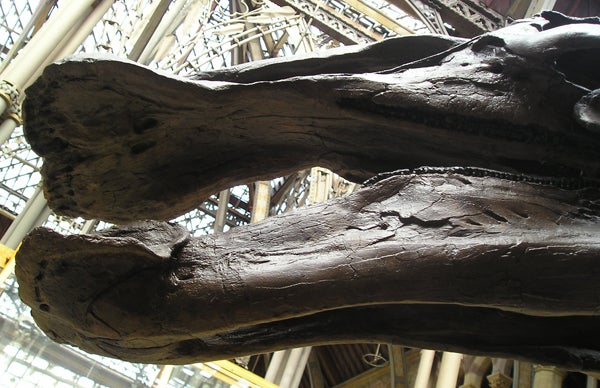
The expanded premaxillae at the tip of the upper jaw of Edmontosaurus give the skull a superficially duck-like look. And this has influenced hundreds of life reconstructions. This specimen is a cast on display at the Oxford University Museum of Natural History, UK. Credit: Darren Naish
On supporting science journalism
If you're enjoying this article, consider supporting our award-winning journalism by subscribing. By purchasing a subscription you are helping to ensure the future of impactful stories about the discoveries and ideas shaping our world today.
The main reason for Edmontosaurus’s fame, however, comes from its wide, flattened ‘duckbill’. So marked is this condition that the term ‘spoonbill dinosaur’ was preferred initially, gradually loosing out in the popularity stakes during the early 1900s (Creisler 2007). The idea that certain hadrosaurs were ‘duckbilled’ was – for some authors – part of their reason for favouring amphibious or aquatic habits in these animals. After all, if it looks like a duck etc. etc...
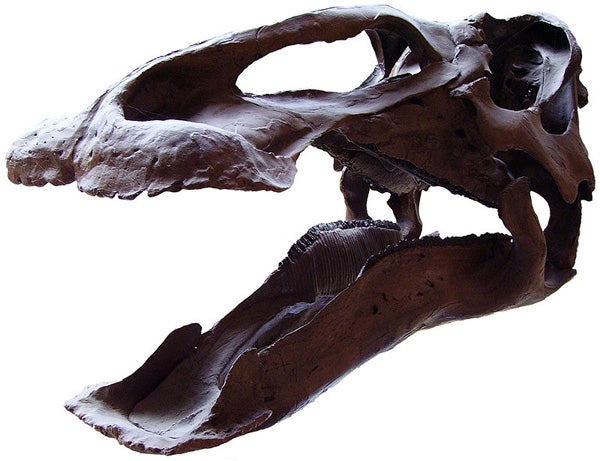
The massive skull of the famous hadrosaur Edmontosaurus. Note the flattened, expanded region at the front of the upper jaw (formed by the premaxillae), and short distance between the enormous hollows associated with the nostrils and the leading edge of the premaxillae. Those huge concave regions surrounding the nostril openings – properly called narial fossae – indicate that a whole lot of interesting soft tissue anatomy surrounded the nostrils, but that’s a subject for another time (and you might recall the related article on ceratopsian nasal anatomy). Credit: Ballista Wikimedia (CC BY-SA 3.0)
But here’s the thing. We’re talking here about the shape of the bones alone. And animals aren’t just made of bones: they have cartilage, muscle, skin and all manner of other tissues on top of those bones. We know – both due to intelligent inference based on the anatomy of living reptiles and to exceptionally preserved fossils like those mentioned above – that the bones at the front of ornithischian jaws were sheathed in beak tissue, properly called rhamphotheca. Which then leads us to ask: were hadrosaur jaws really ‘duckbilled’? Here I’ll cut to the chase and say that we have preserved beak tissue of Edmontosaurus.
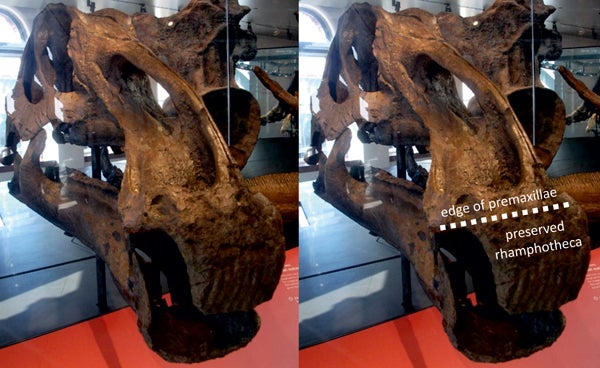
The complete Edmontosaurus skull LACM 23502 in Los Angeles, with rhamphotheca (beak tissue) in place and preserved (though partly prepped away on the skull’s right side). Note that the rhamphotheca extends way, way beyond the edge of the premaxillae (the paired bones that form the tip of the upper jaw). Credit: Darren Naish
In the photos here, you see the rhamphotheca preserved in an Edmontosaurus specimen (LACM 23502) on display at the Los Angeles County Museum. I’ve labelled the rhamphotheca and the underlying bone such that you can see where the bone ends. A weird thing that should be obvious is that a good section of the rhamphotheca on the skull’s far right is missing, as if it were cleaned neatly away from the bone. It turns out that this is exactly what happened. Apparently, a preparator initially mistook the rhamphotheca for uninteresting adherent of nondescript form and began prepping it away. Luckily, a palaeontologist (marine mammal expert Lawrence Barnes, if memory serves) saw what was happening and suggested that progress be halted.
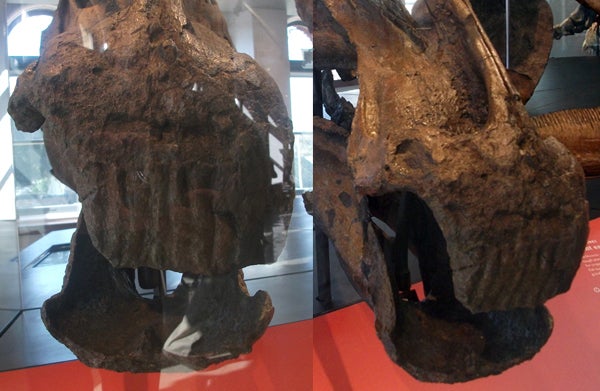
More detailed images of the Los Angeles skull again, figured to show those prominent vertical striations. Credit: Darren Naish
Note also the vertical striations on the rhamphotheca. They remind me of the pillar-like structures ordinarily present on the bone adjacent to the rhamphotheca and on the inside (lingual) surface of the relevant bones, but here it really looks as if they’re on the outside (labial) surface of the rhamphotheca. Julius Csotonyi came to the same conclusion when incorporating these details into a life reconstruction that features in the same museum gallery. However, they might actually show that we’re looking here at an internal mould, and that additional beak tissue was originally attached to the outside of what’s preserved. This was the interpretation favoured by Morris (1970) in his description of this specimen: if correct, it would mean that the beak was even bigger than shown here!
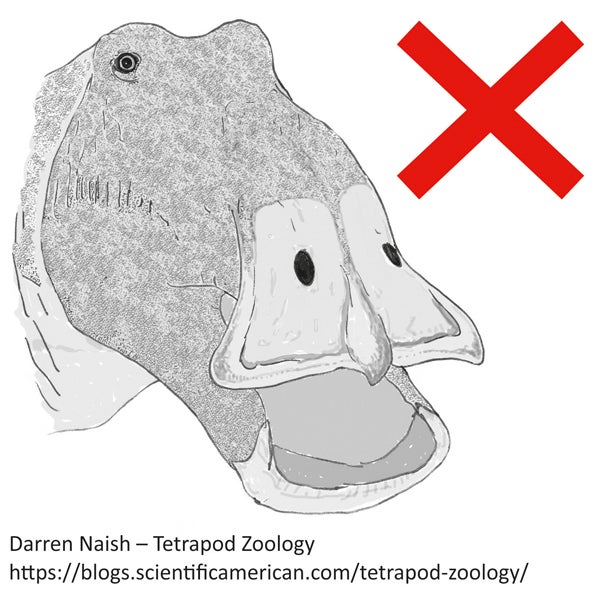
A ‘classic’ reconstruction of Edmontosaurus, depicting it with that conventional, duckbilled look. Credit: Darren Naish
So… what does this mean for the shape of the beak, and for Edmontosaurus as a whole? It means that this dinosaur – remember, it’s the classic ‘duckbill’ – was not duckbilled at all when alive, instead being equipped with a massively downturned, hooked bill that extended way beyond the underlying bony margins of the jaw. That classic expanded, flattened section of the snout we’re so familiar with due to its appearance in skulls was completely submerged, and – overall – the snout looks more suited for gripping, ripping and breaking things than doing anything ‘duck-like’. All of which is in keeping with data from coprolites, stomach contents and so on, since this shows that hadrosaurs were consuming hard-core materials like conifer needles, twigs and even bark. You can’t break off and process those materials with a flattened ‘duckbill’. Incidentally, this discovery of actual beak shape is not novel: Versluys (1923) illustrated and described it decades ago.
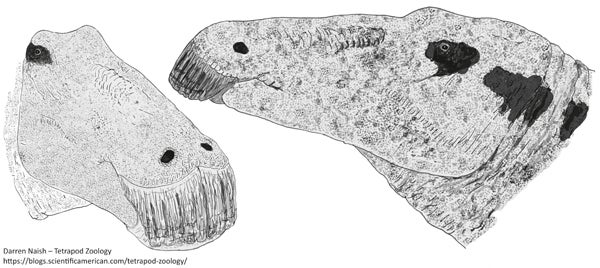
In life, Edmontosaurus would have looked something like this. That broadened, flattened ‘duckbill’ look to the bones was completely obscured, and a giant, downturned, gnarly bill was the dominant feature of the face instead. Credit: Darren Naish
A live edmontosaur was not, therefore, the flat-snouted, wide-mouthed dinosaur you know from older life reconstructions, but one with a very different, hook-billed look. It’s a fantastic – if possibly frustrating – reminder that fossil animals, when decked out with appropriate soft tissues, may often have looked quite different from traditional interpretations.
UPDATE 1: since I published the article you’re reading now, it’s been brought to my attention that Brian Switek blogged about the same specimen – and made the exact same point that I’m making in this article – back in 2012. My apologies to Brian for not crediting this earlier; I think I read his article when it came out, but 2012 is a loooong time ago...
UPDATE 2: I also have to confess that I’d forgotten about Morris’s 1970 paper on the specimen discussed here until Andy Farke reminded me of its existence via social media. While I do mention Morris’s paper above, I don’t sufficiently credit or discuss his idea that the ‘visible surface of the rhamphotheca’ in LACM 23502 is an internal mould of the beak, not the beak itself! What this means is that the actual beak would look quite different from what I’ve shown in the reconstructions here. I will return to this topic in time. It doesn’t invalidate the main point I’m making here though.
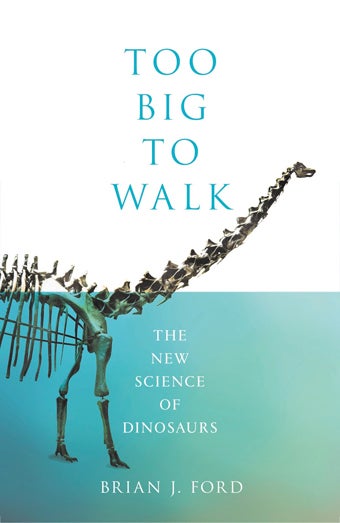
The cover of a book. Credit: HarperCollins
The Ford Debate. It’s not coincidental that I happen to write about all of this at exactly the same time as I’m preparing for what’s become known as the Ford Debate. As covered here at Tet Zoo before (and addressed in print too (Naish 2012)), Brian Ford has argued in recent years that non-bird dinosaurs – all of them, essentially – were aquatic. He has some vague, arm-wavy reasons for thinking this: that dinosaurs were just too big, or had tails that were just too heavy…. And, in just a few weeks, he has a new book out on this very subject, titled Too Big To Walk. Yes, we’ve fallen into a time-tunnel and have landed back in 1933. As part of the promotion for this book, Brian is giving a talk. But, the good news: guess who’s giving a talk at the same event? Yup. You can buy tickets here.
For previous Tet Zoo articles relevant to hadrosaurs and other issues mentioned here, see…
Early abelisaurs and fan-crested and stretch-jawed hadrosaurs
Pads and notches in the necks of tube-crested hadrosaurs… SAY WHAT?
There are dwarf, island-dwelling, cursorial, tridactyl hadrosaurs now: didn’t you get the memo?
Refs - -
Bell, P. R. 2014. A review of hadrosaurid skin impressions. In Eberth, D. A. & Evans D. C. (eds) Hadrosaurs. Indiana University Press, Bloomington & Indianapolis, pp. 572-590.
Creisler, B. S. 2007. Deciphering duckbills: a history in nomenclature. In Carpenter, K. (ed) Horns and Beaks: Ceratopsian and Ornithopod Dinosaurs. Indiana University Press (Bloomington & Indianapolis), pp. 185-210.
Horner, J. R. 1984. A “segmented” epidermal tail frill in a species of hadrosaurian dinosaur. Journal of Paleontology 58, 270-271.
Morris, W. J. 1970. Hadrosaurian dinosaur bills - morphology and function. Los Angeles County Museum, Contributions in Science 193, 1-14.
Naish, D. 2012. Palaeontology bites back... Laboratory News May 2012, 31-32.
Osborn, H. F. 1912. Integument of the iguanodont dinosaur Trachodon. Memoirs of the American Museum of Natural History 2, 33-54.
Versluys, J. 1923. Der Schädel des Skelettes von Trachodon annectans im Senckenberg-Museum. Abhandlungen der Senckenbergischen Naturforschenden Gesellschaft 38, 1-19.